 The magazine of Christopher Ward. Issue 27. Winter 2022
The magazine of Christopher Ward. Issue 27. Winter 2022


 The magazine of Christopher Ward. Issue 27. Winter 2022
The magazine of Christopher Ward. Issue 27. Winter 2022



Our latest watch is designed for two testing environments. Underwater dives to 300 metres and under cuff wear-ability, (whilst diving around desks). The first is self-explanatory. The latter a direct response to feedback from our forum: “We want a C60 Trident that still gets noticed without feeling its presence as much on your wrist.” Introducing the C60 Trident Pro 300: averaging 1.75mm lower and 14.67g lighter across its four-colour, three-size range. It also sports lots more ‘lume’, so you’ll remember it’s still on at night. And an ‘exhibition’ case back, showing off its decorated Swiss movement. How’s that for transparency?
Our latest watch is designed for two testing environments. Underwater dives to 300 metres and under cuff wear-ability, (whilst diving around desks). The first is self-explanatory. The latter a direct response to feedback from our forum: “We want a C60 Trident that still gets noticed without feeling its presence as much on your wrist.” Introducing the C60 Trident Pro 300: averaging 1.75mm lower and 14.67g lighter across its four-colour, three-size range. It also sports lots more ‘lume’, so you’ll remember it’s still on at night. And an ‘exhibition’ case back, showing off its decorated Swiss movement. How’s that for transparency?
Do your research.
Do your research.
christopherward.com christopherward.com




 The magazine of Christopher Ward.
The magazine of Christopher Ward.
When we began planning this issue of Loupe, we knew we were going to place the Bel Canto front and centre.
But as well as covering the story of how this extraordinary timepiece came about, it also sparked us to devote much of this issue to the pleasures and possibilities of sound.
Your first port of call should be Matt Bielby’s in-depth article on the Bel Canto on page 16: taking in everything from its origins to the endless testing of its unique chiming mechanism.
You’ll also find an enlightening article about ‘sound artist’ Sam Belinfante and his immersive exhibitions, while founder of Opera Holland Park, Michael Volpe, educates us on ‘bel canto’ – the style of opera that gave our new watch its name.
As if that wasn’t enough, we’ve got an exclusive interview with Everton F.C. manager, Frank Lampard, in which he talks about his love of watches, his views on the Bel Canto and his leadership philosophy. You won’t read it anywhere else.
It has been another momentous year. War in Ukraine; a cost of living and energy crisis; and the sad death in September of Queen Elizabeth II. At times, the world has seemed wobbly on its axis, and the pursuit of making watches almost an irrelevancy.
Yet amid all the tumult, the team at Christopher Ward have contrived, somehow, to fashion some of the best watches we’ve ever made. The exquisite Aquitaine Collection was followed by the colourful 36mm Sealanders, while the slimmer, lighter, brighter Trident Pro 300 set new standards of design, quality and value for dive watches.
But the best was yet to come.
The C1 Bel Canto that adorns the cover of this magazine is deservedly celebrated within its pages, and captures everything that’s special about watchmaking in general and Christopher Ward in particular. And it reminds us of why doing the very best you can do, no matter your arena, is always worthwhile.
Mike & Peter Editor: Anthony Teasdale Director: Jamie Gallagher Designer: Sam Burn Photography: Peter Canning1 Park St, Maidenhead, Berkshire SL6 1SL



Christopher
Military
gets its first
since its
a

after

Since its launch in 2019, Christopher Ward’s Military Collection has been a byword for authenticity, quality and innovation.
This shouldn’t be a surprise. The series is officially approved by by His Majesty’s Armed Forces, and CW is one of only five watch brands globally to hold this honour.
So when it was decided that the all-chronometer range needed an up grade, the company knew it had to go beyond a ‘refresh’ – into a fundamental refresh. As Christopher Ward CEO Mike France says: “Such is the reputation of the British Military, we had a responsibili ty to make the best even better.”
So far, the Military Collection has produced five timepieces. The first three in the range; the vintage-styled C65 Sandhurst, C65 Cranwell and C65 Dartmouth, are all named after the prestigious officer-training academies of the Royal Navy, Army and RAF. And it’s these ‘Series 1’ models that have now been completely renewed – with one new addition – by CW’s design and manufac turing teams.
Few of Christopher Ward’s watches have achieved the popularity of the C65 Sandhurst. Based on the Smiths W10, a field watch issued to British sol diers in 1969, its understated, ultra-leg ible design has gained fans worldwide since its release.
“The new Sandhurst still has the same 38mm Light-catcher™ case,” says designer Will Brackfied. “But now it’s got arrowed, full-brushed hands, bringing it in line with our current design aesthetic.

We’re also releasing a new Sandhurst Bronze for those who love the warm look of bronze and the way it patinates.”
The second watch is the C65 Cranwell, which has received the most significant redesign of the trio. Originally modelled on the Jaeger-LeCoultre Mark XI 6B/346, an aviator watch aimed at bomber-nav igators using celestial ‘look-up’ naviga tion, its case has been reduced to 38mm, while the dial has had a comprehensive redesign.
Finally, the C65 Dartmouth. Mod elled on the 1957 Omega Seamaster 300 ‘Big Triangle’, it’s long been a favourite with vintage dive-watch lovers, but this second iteration takes it to a new level. Maintaining its 41mm case, it now boasts an incredible fully-lumed dial and sapphire bezel (also lumed) –showcasing the advances CW has made on watches like the #C60 tide, and the Aquitaine Collection.
“With the Cranwell and Sandhurst, we have two ultimate field watches, while the Dartmouth is now the ultimate retro-dive watch – albeit with a lumeheavy dial that wouldn’t have been possible in the past,” says Mike.
Another difference between the new military watches and the previous generation is the replacement of the ‘Christopher Ward’ logo with the twinflags emblem. “The use of the twin-flags logo brings these timepieces closer to the watches that influenced them,” says Will. “While they were produced by com panies like Omega, Jaeger-LeCoultre and Smiths, their logos weren’t shown on the dial."
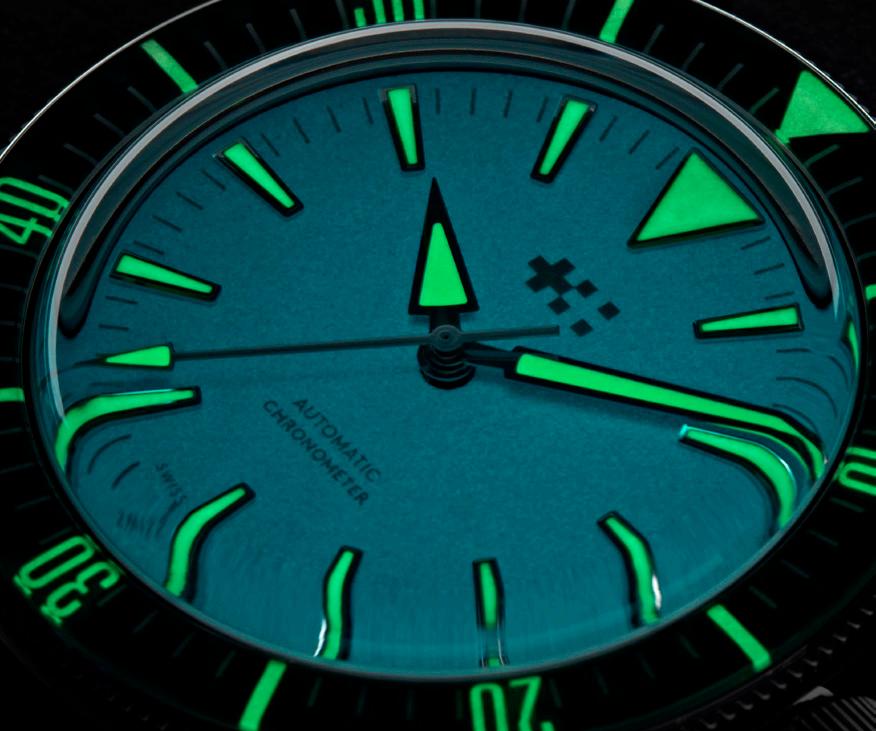
One thing that’s marked out the Military Collection out is the use of chronometer movements. There’s a reason for this, which dates back to the years after World War II.
“The military has always relied on accurate timing,” says Mike France. “The timepieces these three watches are modelled on boasted mechanical move ments with chronometer-level accuracy.
The C65 Dartmouth’s lumed dial
The Smiths and JLC pieces also had a ‘hacking seconds’ function which allowed soldiers and pilots to synchronise watches with the utmost accuracy. It’s a tradition we’re pleased to maintain.”
Christopher Ward’s partnership with the Military of Defence is a testament to the company’s admiration for the UK’s Armed Forces.

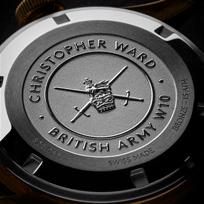
“These timepieces are a homage to a unique era of watchmaking and the personnel that relied on them,” says Mike France. “The new Military Collection watches are a significant step forward in design and engineering, while retaining the fundamental design cues of three of the greatest military watches in history.”
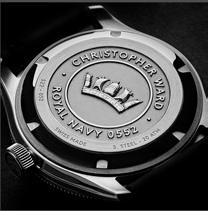
Finally, one thing remains from the previous generation: the combination of premium watchmaking and value for money that makes these beautiful watches accessible to as many people as possible. A tradition that Christopher Ward is very proud to uphold.
 The new C65 Cranwell
The new C65 Cranwell
Christopher Ward’s partnership with Everton F.C. will bear its first horological fruit next year with a limited edition chron ograph dedicated to the achievements of striker William Ralph’ Dixie’ Dean.
Dean is most famous for scoring an as tonishing 60 goals in Everton’s title-winning season of 1927-8: a record yet to be beaten by any striker in England’s top division.
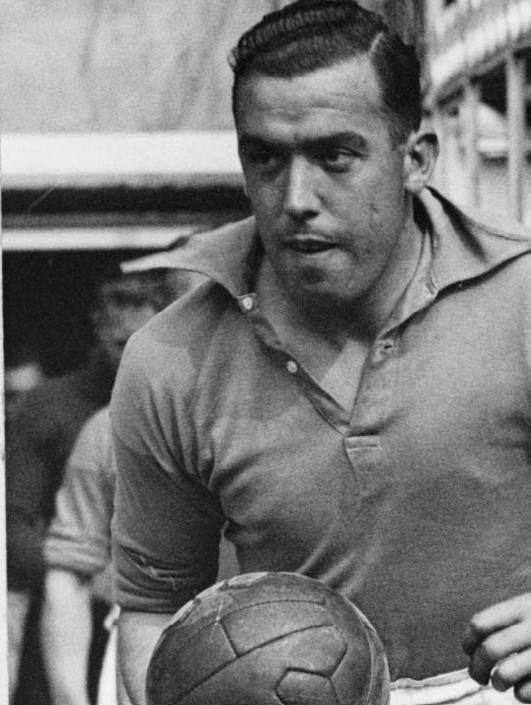
“As an Evertonian, Dixie Dean has a special place in my heart,” says CW CEO Mike France. “So it seems natural that our debut timepiece with Everton will pay tribute to him".
This will be a limited edition of just 60 watches, and each one will celebrate an individual goal with an engraved screwplate on the dial, plus details of the goal on the back plate.”
The football connection doesn’t end there. Both the specially designed bezel and one of the subdials will allow the wearer to measure 45 minutes: the length of a half in a football match.
“We’re not interested in making thou sands of run-of-the-mill watches with an Everton crest on the dial,” says Mike. “Instead, we want to create only very special timepieces that celebrate Everton Football Club. The first in the series will set a high benchmark.”
The ‘Dixie’ watch will be released next year, and further Everton watches will follow that
Christopher Ward’s Bespoke division has created hundreds of unique watches for organisations all over the world.
And now, it’s embarking on one of its most ambitious projects yet: a two-watch series for the Royal Canadian Mounted Police to celebrate the force’s 150th anniversary in 2023.


The first watch is a 150-piece limited edition of the C63 Sealander GMT with a COSC-certified movement. There’s also a second timepiece: a C63 Sealander Automatic, that will be available as a regular, non-limited edition.
Both watches will feature the RCMP’s colours of blue, red and yellow, and will play host to their crest on the dial – which will also be deep-stamped in the case back. A special rubber strap has also been produced.
“Working with an organisation like the RCMP is a huge honour for Christopher Ward,” says Bespoke business development manager, Peter France. “And what we’ve created will do the 30,000 serving mounties and 50,000 ex-officers proud. It also shows how far we’ll go to create a watch that’s unique to an organisation.”
The watches will be available in 2023.
Interested in commissioning a watch from CW’s Bespoke team? Email peter.france@christopherward.co.uk
Christopher Ward’s Challenger programme gives help to those with extraordinary abilities and drive – but with out the finances to follow their dreams.
Over the last few months, two Chal lengers have achieved great success. At the Commonwealth Games in August, wheelchair racer, and Challenger alumnus, Sammi Kinghorn (left) won bronze in the T53/54 1500m final. Sammi recorded a time of 3:53.38 – just eight-hundredths of a second away from the silver medal.
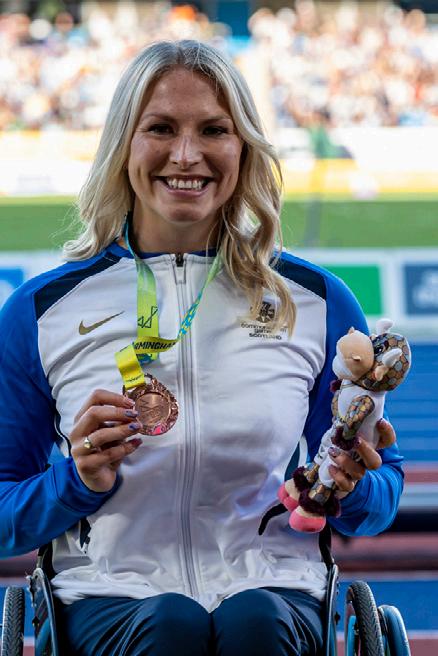
one of the most challenging bike races in the world.
The 1,895km route goes through the Tian Shan Mountains before ending at Bishkek, Kyrgyzstan’s capital. James completed it in just over seven days and six hours, only 59 minutes behind the winner, Sofiane Sehili.
Christopher Ward is one of the founding members of Alliance of British Watch and Clock Makers, established in 2020 to promote British horology. The Alliance has just marked its second anniversary with a radical refresh of its website and Instagram channel.

One of the world’s most famous watchmakers, Roger Smith, is the Alliance’s chairman. “Now is the time to showcase everything the British sector can offer,” he
Another Challenger who’s had an incredible summer is endurance cyclist James Hayden. James came second in the Silk Road Mountain Race in Kyrgyzstan,
“He was nine kilometres ahead with 130km to go,” says James. “I managed to get so close I could see his rear tail light – he was only 300m ahead. As we went toward Bishkek, my body gave up as I hadn’t eaten, and I collapsed by the side of the road. There was nothing left. Eventually, I came second, 59 minutes behind the leader. The guy in third finished 27 hours behind.” says. “We’re excited that our new website provides the ideal portal for visitors to get closer to the brands pushing UK watch making forward."
The Alliance isn’t just for watchmak ers – it also offers a ‘Club’ membership for enthusiasts, with a range of benefits, including complimentary copies of Oracle Time and GMT magazines, exclusive access to virtual events and now, limited edition watches.
CW’s Mike France says: “The first watch will launch in 2023 and is a collaboration watch between Christopher Ward and fellow Alliance founding member, Fears. Called the Alliance 001, there will only be 50 pieces made, and they’ll be exclusively available to Club members. Our aim is for this to be the first in a series of watches created by Alliance members, showcasing just how collaborative the UK sector is.”
It’s only in the last decade that 1970s watch design has become appreciated – witness the price of vintage Royal Oaks, Speedmasters and Nautiluses for proof.
And nowhere is this appreciation stronger than in the Christopher Ward de sign studio. Over the last few months, the team has been working on a new watch series with a distinctly 1970s feel.
“There’s one genre of watch that our collection is missing,” says Mike France, Christopher Ward CEO. “Now we’re on the way to closing that space.”
Designer Will Brackfield has already been testing designs, with the 3D-printed prototypes being sent over from the CW atelier in Biel.
“It’s early days,” he says. “But we want to make the most ergonomic watch we can. I can also tell you that this is the first bracelet we’ve designed with a butterfly clasp. Achieving this has been difficult, but we’re getting to the stage where I’m happy with it.”
The watch will come in stainless steel and titanium versions, with at least 100m of water resistance thanks to the screwdown crown.
“There’s going to be a further step up in finishing,” says Will. “We’re paying particular attention to the dial, so it plays with the light when you wear it.”
More details will emerge in the next issue of Loupe – the expectation is the watch will be released in 2023.
After some well-earned holiday in summer, our Biel atelier has been hard at work.
Recently, our focus has been on the Bel Canto watch. Many components have come in from individual suppliers, including Armin Strom, who produced the bridges on the C60 Concept. They’re great to work with and one of the most respected names in our industry – we’ll be collaborating with them again.
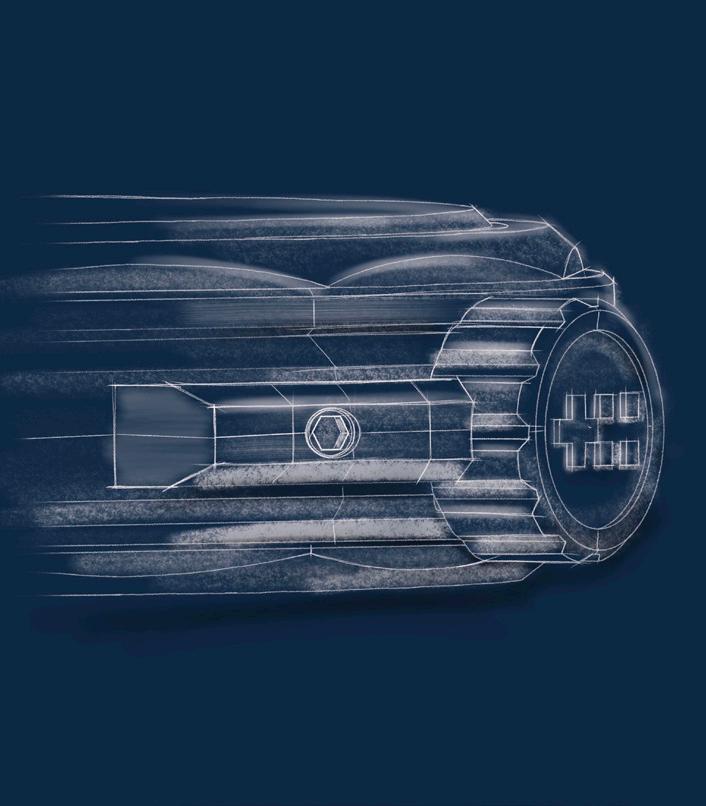
With the Bel Canto, the most impor tant thing was to fine-tune the sound. To check the sound curve of the chime, we ordered a special machine constructed by students from Bern University, who made it as part of their course. We did it with every individual watch!
Another watch that’s taken up a lot of our attention has been the new C60 Trident Pro 300. This came on immedi ately after the holidays, and we had to work late nights and weekends to fulfil the orders. We think it’s an improvement on what’s come before – and we’re proud we’ve been able to do this while also reducing the price.
It will get busy as we head toward Christmas. I think everyone here likes this: it’s challenging. We’re not a fully industri alised assembly house, so we must keep vigilant as every watch is made by hand.
When you look at where Christopher Ward is at the present moment, we’re still an under-the-radar brand in Switzerland, and that suits us fine. The mix between the creativity of the English side with Swiss watchmaking expertise puts us in the per fect position to continue to innovate.
 Jorg Bader Jr, product manager, Biel
Jorg Bader Jr, product manager, Biel

Sam Belinfante is an artist who places sound at the heart of his output. Creating works that take in music, art, film, live performance and installations, he’s best known for his Listening exhibition that toured the UK between 2014-16. Here, we talk to him about how sound can be in corporated into art, using the solar system as a starting point for a performance and how blood circulation inspired his most recent work.
Hi Sam! How did you get started as a ‘sound artist’?
I’ve played cello all my life and can sing to a decent standard, but I went to art school to do that in the day and play music in the evening. But when I got there, my teachers suggested I make art about music. I’ve been lucky enough to make a career around these disciplines; creating works for the studio, theatre, gallery, opera house –inside and out. I work across the senses!
You came to attention with the Listening exhibition – which ‘examined the crossover between the visual and the sonic’. Tell us about it…
The idea was: “What happens when you do a show about listening?” Getting people to be led by their ears as much as their eyes. There’s a saying: “The ears have no lids” – you can’t shut them off, so curators and artists are apprehensive about sounds in exhibitions because they ‘bleed’. My approach was to choreograph the whole thing, with the show becoming a kind of musical instrument.
The exhibition was ‘in time’ – you were led around by things happening in that space. There were lots of artists and musicians involved, like Laurie Anderson [writer of futuristic 1981 hit Oh Superman] and anoth er sound artist, Janet Cardiff. Turner Prize winner Laure Prouvost was also involved – we worked with theatrical lights, bringing them into the gallery, and at a certain point in the exhibition, all the lights would go off. Lighting is important: as soon as light changes, you change your behaviour.
In 2021 you produced a large exterior installation, On The Circulation Of Blood, for the Folkestone Triennial. What was that?
The starting point was the work of Folkestone’s William Harvey, who discov ered blood circulation in 1648 – and proved that the heart wasn’t the ‘soul’ but nothing more than a pump. Over two years, I worked with hundreds of people – including local children and musicians –and we created compositions that played with these ideas of pulse, beats and movement. The people’s movements and ideas were the ‘circulation’.
When it comes to bridging the gap between art, music, light and performance, artist Sam Belinfante’s work is there for all to see – and hear
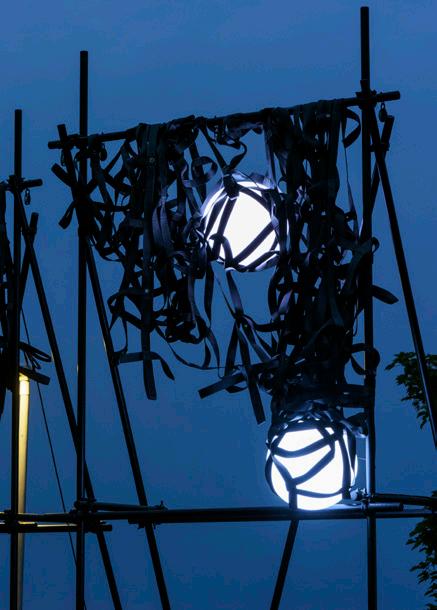
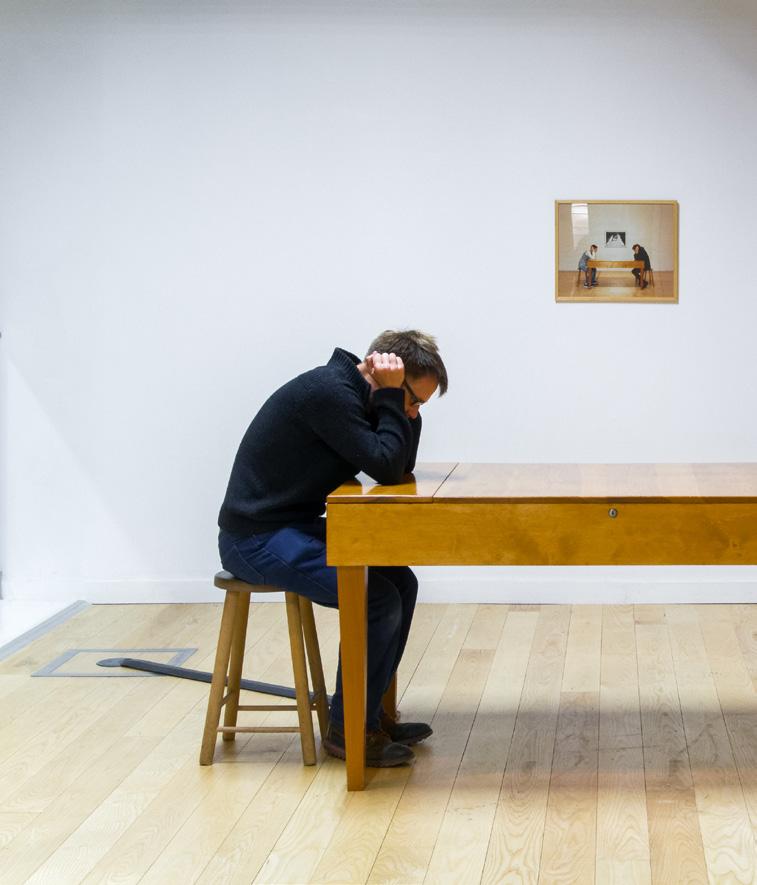
“We used orbs as beacons that set the time for the project with lights and sounds timed exactly to create unexpected, serendipitous music”
It was an outdoor installation construct ed from theatrical apparatuses, fabric netting and a lighting and audio system. The structure was the site for public per formances – and you’d go there to hear the performance. We used orbs as beacons that set the time for the project with lights and sounds timed exactly (and randomly) to create unexpected, serendipitous music. In fishing communities, you had bells and lights that ‘timed’ the town – when people would go out to sea and back. It also refer enced that.
You’ve got a project at the Bluecoat in Liverpool that has a planetary feel…


In 2019, I produced The Orrery for the London Contemporary Music Festival. I’m taking the energy from this into a gallery installation. An ‘orrery’ is a mechanical model of the solar system. They have their own personality – they whir, shake and move around. One thing goes fast: anoth er goes slow – they’re idiosyncratic.
The 2019 Orrery entwined performers and audience in a huge apparatus with a giant moon in the middle, testing the cho reographic and cartographic possibilities of the choral machine. With support from Arts Council England, I’m working with the Bluecoat to see how we can use this approach to make gallery exhibitions.
Moving away from your work, what’s the difference between sound and music?
Music is the organisation of sound: the choreography and sounds going in and out of sync. That includes the silences, too. The composer Felix Mendelssohn said, “Music is in the silences.” It has an end and a begin ning, whereas noise always goes on.
Finally, would you consider yourself a musician or artist?
I’m not throwing away the visual – it’s essential to what I do. I don’t produce music: it’s about the different senses play ing with each other!

ONLY A HANDFUL OF WATCHMAKERS HAVE MASTERED WHAT MIGHT BE THE MOST CHALLENG ING COMPLICATION OF THEM ALL – AN AUDIBLE INDICATION OF TIME. SO GUESS WHAT CHRISTOPHER WARD HAS GONE AND DONE?
WORDS: Matt Bielby


Meet the C1 Bel Canto, argua bly Christopher Ward’s finest horological hour. It marks the debut of a brand new in-house calibre, FS01. It feels utterly alive, marking each hour with its cheerful, reassuring internal chime. And it sees CW assert its horological ambitions like never before.
Although Christopher Ward is best known for its sports watches, the com pany has a parallel history too, one that constantly pushes the creative envelope. It’s this strand that produced in-house movement Calibre SH21, and was responsible for the legendary JJ calibres, unique modules piggybacking on existing movements.
As the name suggests, all were designed by Johannes Jahnke, CW’s first master watchmaker. But FS01 is the first of a new series, named after current technical director Frank Stelzer, and is the most ambitious yet. In all horological history, little has tested the watchmaker like creating sound, so it’s no wonder Bel Canto took three years of tortuous development.
Bel Canto is what’s called an hour chime, or – more romantically – a Sonnerie au Passage complication, which translates as ‘passage of time’. Sound has a long history in timekeeping, with entire commu nities revolving around the chime of a town clock. But though a pleasant sound is easy to create in a huge tower, on the scale of a mechanical watch it becomes very difficult indeed.
“Bel Canto is an extrapolation of the C60 Concept, in that we're taking the high est quality hand-finished components and putting them within reach of many,” says Jörg Bader Junior, head of product at CW’s Biel atelier. “But in terms of technological challenge, it’s taken us into uncharted terri tory. You can buy books on how a tourbillon works, but there’s nothing on watch chimes – and the high-end brands that make them are incredibly secretive. We had to figure everything out for ourselves.”
With each JJ calibre, the desire wasn’t just to produce a complication, but to do it in a fresh, efficient way. Ten years ago, JJ01 was designed to offer the most accurate jumping-hour function possible and, by
spreading the load over an entire hour, Johannes managed it. His success became one of the starting points for FS01. Anoth er, however, is more unexpected.
It’s a little known fact that Christopher Ward creates watches for MeisterSinger, the German specialist in single-hand time pieces. A few years ago Frank made a new model for them, the Bell Hora, a Sonnerie au Passage. So, could something similar be done for Christopher Ward?
“The Bell Hora was a stepping stone,” says CEO and co-founder Mike France. “But with Bel Canto we wanted to bring the striking mechanism to the front, so the wearer could watch it in action. The ques tion became: could we make a chiming watch both look and sound beautiful at the same time?”
While the closed-face MeisterSinger was created in the functional German style, Bel Canto would be a show-off. The movement would operate in a way that made sense to the viewer, which meant pulling the important elements forward, while emphasising pleasing shapes throughout.


FROM THE PLATINE THROUGH THE BRIDGES TO THE
SUBDIAL


“Finding a way to split out the com ponents so they felt balanced across the entire face, was complicated,” says CW watch designer Will Brackfield. “Each time we moved one piece, it had a knock-on effect on the others. The platine – the blue module plate behind the important elements – would have a gorgeous sunray finish, so we needed to find a way to hide minor components behind that too.”
Frank began with a Sellita SW200-1 automatic base movement paired with JJ01, which charges incrementally over an hour to then make a single movement. But his modifications would eventually involve the creation of 50 new components, and become a race against time once an onsale date of autumn 2022 was confirmed.

“One of the great challenges was striking the right balance between note and loudness,” says head of product design, Adrian Buchmann. “To make an averagely pleasant sound is easy, but a beautiful one is hard. The gong – in this case, a giant spring – needs to be perfect: the material, length, shape and finish all just so. And it’s the same for the hammer, and the case; change any of these and you change the sound. We soon learned that the case would have to be made of Grade 5 titanium, a material we’d never used before, with lots of empty space and resonance points. It’s a very dense metal – and creates a sound cage with the best possible vibrations.”
So, what exactly does a Christopher Ward chiming watch sound like? Here there are some differences of opinion. “Ele gant,” says Mike. “Luxurious,” suggests Will. “A long, high-pitched note,” says Adrian.
No one can quite define it – it is more like a xylophone, or a hotel bell? – but all agree that it’s delightful. Technically, it turns out to be a D, also known as Re (“a drop of golden sun”) on the fixed do solfège system, familiar from The Sound Of Music
“One thing everyone comments on is how the bridge structure towards the bottom looks like a bird,” Mike says. “The red ‘beak’ is actually the on-off mecha nism, controlled by a pusher at 4 o’clock, and moves to indicate whether the chime is on or off, while the hammer is its tail. Bel Canto means ‘beautiful singing’, so there’s whimsical humour going on which seems very Christopher Ward.”

“IN TERMS OF TECHNOLOGICAL CHALLENGE, IT’S TAKEN US INTO UNCHARTED TERRITORY”






Other details befit such an ambitious piece. The dial consists of intriguingly stacked layers, rising from the platine through the bridges to the time-telling subdial, while the 41mm C1 Lightcatcher™ case has been given a subtle sporty makeover.
For reasons of drama and elegance, there’s no seconds hand, leaving – at the moment it strikes – the hammer as the only moving element on the dial. On smooth blue vicuña leather the watch feels elegant and refined, while a brand new titanium bracelet gives a sharper, sportier look. Hand-finishing throughout is incredi ble too, adding up to a full third of the cost of the FS01 module.


“There are so many firsts with this watch,” Adrian says. “We’ve never used Grade 5 titanium before, and we’ve never stressed over the exact dimensions of a case to this extent. Many chiming watches are around 47mm, as it’s easier to get a nice note from a larger case, but we worked tirelessly to pull that down.”
Of course, CW couldn’t do this alone, and Bel Canto is also a tribute to many brilliant suppliers and partners, all noted specialists in their fields. Perhaps the most famous is Armin Strom, maker of high-end open worked watches, which contributed the platine, but Chronode (the bridges, hammer and gong) and Viquodeco(the special wheels required) were also crucial.
“A chime is such a charming complica tion because you bond with it in a unique way,” Mike says. “There’s this little noise each hour that’s like a personal message to you. Those who really understand watch making, and appreciate what an achieve ment this is, will find it the most exciting thing we’ve done.”
It goes without saying that Bel Canto is considerably more affordable than any comparable watch. In fact, on a leather strap it’s only £2,995, while on the titanium bracelet, £3,305.
Quite simply, no brand anywhere has made the art of sound so accessible, or opened up the possibility of owning such high horological art to so many.
Our feathered friends are given due respect in a beautiful new photo book
It’s easy to take birds for granted. Like anything you see daily, birds blend into the background – only interrupting our conscience when they peck at our favourite garden plants or steal your children’s chips at the seaside (we’re looking at you, seagulls). You’ll even find a ‘bird’ in min iature mechanical form on the dial of the new Bel Canto timepiece.
That’s why a new book, Birds, edited by Gemma Padley, is so timely.
A collection of avian portraits by some of the world’s best photographers, it shows birds for what they really are: exquisitely designed flying machines free to explore the world without the heavy hand of gravity to hold them back.
Some images are portraits that project their subjects’ personalities – The Magnificent Chicken by Tamra Staples, for example (see facing page)– while others place the birds
in their environments – perching on power lines (parakeets) or fishing in a pond (flamingos).
There’s not just beauty here, though that’s in abun dance, but drama, humour and pathos, too. Luke Stephen son’s Spreo Starling #1, 2019, has the same intimate and melancholic quality as Carel Fabritius’s 1654 painting, The Goldfinch
Each photo set is accompanied by text from Padley, who adds essential information about the breed in ques tion and the story behind the pictures.
“What unites all these projects is their ability to breathe new life into a timeless subject,” she says. “They artfully and playfully encourage us to look again at the boundless wonders of the avian world."
Bird is published by Hoxton Mini Press; hoxtonminipress.com







A legend at Chelsea and one of England’s greatest midfielders, Frank Lampard is now manager at Everton, and has a lot to say about footballing philosophy and what the beautiful game has taught him about life


When it comes to elite football, Frank Lampard has seen and done it all. As a player, he won Premier League and Champions League titles with Chelsea, while playing 106 times for England. Now he’s one of the brightest young managers in the English game, and is currently at Everton, where he’s aiming to revive the fortunes of this famous old club.
As Everton’s official global timing partner, Christopher Ward’s team were granted time with Frank at the club’s Finch Farm training complex just outside Liverpool to talk about his plans for the Blues, his leadership style and why he’s sizing down his watch size.


Hi Frank. You’ve made a strong con nection with Everton. Why?
It’s a mixture of circumstances. It was a tough time on a footballing level when I first came in and there’d been a breakdown between the fans and club. I knew it was important to build the bridge again. I was a bit concerned about being a London boy coming up to Everton. But from the moment I came in, I felt this real support. Those things – particularly in the Liverpool area – they need to be authentic. If you fake it, Evertonians will see through you.
That’s true…
I threw myself into it! Around 80 percent of the people who work here [at the club] are Evertonians – you see the Everton tattoos everywhere. It got me. I felt com fortable very quickly, especially when I saw how the fans were supporting the players, from the incredible coach welcomes at the stadium to the send-offs they gave us at the training ground.
When was this?
The Chelsea game in May [which Ever ton won 1-0]. Burnley had beaten Watford the previous day, and we were five points away from safety with two games in hand. The fans stepped in and helped. What we saw from them is something I’ve never seen in football. It lifted us and brought us all together.
Going into a new club is difficult. What did you do when you came in?
We took the non-playing staff – med ical, kit and analysis staff – into Liverpool city centre for a big dinner after about two weeks here. We all mixed together: we just had a beer. Football, business and life is about people. If you’re a player you’re selfish, but as a manager you have to think about the group. When you come into a club that’s struggling, the priority is: how do we build confidence? That started with the training, the team, the squad – and then
the club – the club needs positivity, too. The fans appreciated the honesty.
How do you cope with the spotlight?
You prioritise. You take on a lot more responsibility. Can you find time to be with your family or have down time? My family is what makes me happy. I go out a lot less than I used to. I find a nice balance of my job and being with my family. You realise you’re driven – and I want to do the best I can.
How did you learn to be a manager?
I finished playing, worked in the media for a year and at the same time I was also doing my FA coaching badges. You work up some coaching hours, and get together with other coaches, and the FA teaches you about media and other scenarios. But, ultimately, nothing can fully prepare you for it – it’s only when you become a manager that you really start to learn what it’s all about.
Then you went to see Derby County…
I met the Derby owner by chance. He said, “Do you want to be interviewed for the [manager’s] job?” I sat with him for two hours and was offered the role. I took the job. And I learned on the job. I had experience of being a player but about 20 percent of that relates to being a man ager. The amount of questions you get:
Culture is huge. Unless you can set a culture, a lack of identity is a problem. When things are go ing well you can get by, but when times are tough that’s when you rely on culture and values.
what time do you want to travel? Do you want them to wear tracksuits? When do you want to train? There are so many things to think about! You make mistake after mistake initially.
Is there a ‘Frank Lampard’ way of play ing football?
You need a basic philosophy. Most modern coaches are the same: they want their team to play great football: high press, win the ball back. It’s not that simple though and it can take time and a lot of work. The important thing is that you have firm beliefs in what you want your team to look like, and also the idea of how you communicate it to your players. At the top level you also have to understand that you will be judged on results. You build the week around your own ideas. Preparation is key. My job is to help the players in the best way to win the game. One of my main things is how to simplify the message. But I can’t tell Anthony Gordon how to cut inside and put it in the top corner – he can do that himself.
Absolutely. It’s something I grew up with. That work ethic was passed down to me from my parents. You have to fail, you have to improve. If you watch Manchester City play, there’s a lot of work that’s gone into that. In elite sport, any small improvements will help you. We practice for an hour and a half to two hours every day. We have to utilise that time – if you don’t, someone else will.
How important is the mental side?
Culture is huge. Unless you can set a culture, a lack of identity is a problem. When things are going well you can get by,
but when times are tough that’s when you rely on culture and values. Look at the best teams, they have values that revolve around the manager, and then around the club. When I first walked in here, I saw quotes on the wall by Alan Ball and Howard Kendall. We need to reconnect with our history, as our recent history isn’t what the long-term history of the club is. And I want us to reproduce it.

What’s been your highlight at Everton so far?
When Dominic Calvert-Lewin scored that header against Crystal Palace [which kept Everton in the Premier League]. It was one of the best moments of my career – up there with winning the Champions League. From 2-0 down, we have 2-1, 2-2, then we’re 3-2 ahead. I’ve never experi enced elation like that! I was delighted for so many people we got it over the line.

Now, onto watches. We’ve got the C60 Trident 300 for you to try on. Blue or green?
In terms of aesthetics, I love blue! But I like green, too. I love the slim nature of this watch. As I’ve got older, I’ve sized down in terms of watches – the older I get, the more I love that ‘flush’ look.
Finally, here's the Bel Canto watch. You’ll notice the mechanism on the front…
I remember the first time I saw a watch mechanism – I thought, wow – amazing! That’s a beautiful watch. It’s got a lovely blue dial colour, too. That’s gorgeous, and it’s the perfect size too.
Christopher Ward is the Global Timing Partner for Everton Football Club Dominic Calvert-Lewin celebrates his goal against Crystal Palace
Bel canto is a style of opera that’s inspired CW’s exceptional new watch of the same name. Here, founder of Opera Holland Park, Michael Volpe, writes a beginner’s guide to this most sensuous of operatic genres
The Italians have a phrase – usually quite literal – for everything; la dolce vita (the sweet life), che sera, sera (what will be will be), buon appetito (good appetite) etc.
In classical music, especially opera, this practice is also prevalent. There are various types of opera characterised by a literal expression. For example, a style of late Italian opera that focused on love and murder and ordinary people’s lives is called verismo – real life.
There is opera seria from the 18th century, which was literally ‘seri ous’ and usually on a classical or mythological theme, or opera buffa, which means ‘comic opera’. And then there’s bel canto which translates as ‘beautiful singing’, a form of opera at the apex of the operatic repertoire and from which many famous pieces of music have emerged. Bel canto isn’t easy to define because it has many facets, and while its heyday was the 19th century, operas in this style are still enormously popular.
It wasn’t as if a sudden new singing style emerged – elements of what we know to be bel canto could be found in early operas. But it’s generally characterised by extended legato (‘joined together’) notes sung smoothly and evenly across the melodic line; the emotional match ing of the music to the drama; florid, ornamental passages of dazzling singing (coloratura) and a general dedication to the beauty of the sound of the voice.
One of the composers most closely associated with bel canto is Vincenzo Bellini. He composed the opera Norma from which the aria Casta Diva was drawn and has become famous worldwide – particu larly the version recorded by Maria Callas.
Bel canto is all about the beauty of sound and emotional expres sion, of the marriage of voice and orchestra. The tone and delivery of
a note, or a series of notes by particular singers, can be the subject of fierce debate among musicologists – it is a search for perfection.
Opera is an enormously varied idiom with many sub-genres ap pearing through the centuries. Bel canto is considered by many to be the pinnacle of operatic achievement by composers from a variety of nations, not just Italians.
It was also an enormous influence on those that came after, composers who forged their own styles but drew on the lessons of the bel canto repertoire. Today, operas by Rossini, Bellini and Donizetti fill theatres worldwide, and these operas represent the era of bel canto most distinctly.
If you were looking for a contemporary music comparison to help describe where bel canto sits within the classical canon, you might imagine the difference between the style of rock played by a band like AC/DC with the soft, melodic version created by Steely Dan.
Many great singers believed bel canto was best appreciated by peo ple with sensitivity and soul. Exceptional singers of bel canto are highly prized and adored. Nevertheless, through history, many have fallen foul of the purists – one creaky note could bring down boos and at particular Italian opera houses, fruit and vegetables might be pelted onto the stage.
Things are a little less brutal now but to sing in a bel canto opera is a monumentally physical and emotional challenge – and singers revere them. The last word goes to soprano Sondra Radvanovsky who summed up the dangers of the great bel canto roles when she said, “Singing bel canto is like walking a tightrope”.

A further death knell sounded for the turntable when downloads and streaming arrived – but it was CDs that were made re dundant, not records. Now we have Record Store Day, sales of vinyl at their highest since the 1990s and a vinyl section in every high street clothes boutique.
Now a beautifully illustrated and per fectly timed book, Revolution, The History of Turntable Design by Gideon Schwartz, tells the story of the record deck.


Filled with 300 photos of every kind of deck: from something you’d have had in your bedroom as a kid to a turntable that looks more like a piece of conceptual art, it’s every vinyl junkie’s dream.
If you value the crackle you hear before the music starts or still think every album has a ‘Side A’ and ‘Side B’, this is a book for you.
The History Of Turntable Design by Gideon Schwartz is published by Phaidon, price £74.95; phaidon.com
Yet they continue to exist, and vinyl records continue to be made because there’s no better way of getting closer to the music you love than through a stylus, record deck, amplifier and speakers.
It wasn’t meant to be this way. Compact discs were forced on us by the music industry in the mid-’80s – not only were they more convenient (their words, not ours), but the profit margins were far greater than with boring and imperfect vinyl.
But humans have the annoying habit of being quite partial to imperfection (it’s why we love mechanical watches).
The first pushback came in the 1990s when club culture heralded a generation of bedroom DJs who didn’t just want one deck but two – usually the robust Technics SL1210 – with which to practice their mixing on.

The USA is a nation of storytellers.
And few can match the tales told by musician Bob Dylan and film director Martin Scorcese.
So it should be no surprise that Scorcese’s exhaustive documentary on Dylan’s golden early period is as original and inspirational as Bob Zimmerman himself.
The film tells the story of Dylan’s trans formation from jobbing folkie in 1961 to his ‘retirement’ in 1966, but thanks to inter views with Allen Ginsberg and Joan Baez, it also places him squarely at the centre of the 1960s counterculture revolution.
And even if you’re not a Dylan devotee – and don’t know why he was called ‘Judas’ at the Manchester Free Trade Hall in 1965* – Scorcese’s ability to weave a story from the wealth of footage (in cluding Dylan playing in his high-school rock band) is reason enough to watch No Direction Home in its entirety.
No Direction Home is available on streaming platforms
* He used an electric guitar – an act of betrayal for hardcore folk fans
The phrase ‘DJs are the new rock stars’ has been around so long that it’s ceased being a cliche and is now an accepted fact.
How did this happen? How did the people who played records become as significant as those who played on them?
Last Night A DJ Saved My Life has the answer. Initially released in 1999 and re freshed for 2022 (with two new chapters), Bill Brewster and Frank Broughton’s history of the DJ is one of the most important pop culture books of the last 30 years.

The story begins with hard-up British promoters paying a proto-DJ to spin re cords rather than pay an expensive band: a move that the all-powerful Musicians Union angrily resisted.
We’re then taken through the dive bars of ’60s London, the hedonistic lofts of New York City and the yard parties of Kingston, Jamaica – witnessing the DJ go from support act to main event. One of the most revealing chapters is on the birth of a disco – taking it away from John Travolta and Boney M, and telling its true story.
“There are just so many elements of disco that are still relevant,” says Brewster. “Editing, remixing, all of this stuff was started by disco DJs in the early 1970s. They’ve contributed so much to dance music culture, particularly to the world of house and techno.”
In a digital-dominated world, where everyone can be a director, filmmaker, magazine editor and documentary maker, the DJ was a pioneer: using technology not just to shape music but to stretch it to its limits in a way that no traditional musician would have dreamed of. This book is a long overdue celebration of that contribution.
Last Night A DJ Saved My Life is published by Hachette
There’s no better way of seeing sculp ture than in the outdoors. And there can be few more beautiful places to do this than Château La Coste in Provence, France.
To call it a sculpture park doesn’t do it justice: Château La Coste is a winery, spa, a venue for chef Francis Mallmann’s only European restaurant and an impossibly gorgeous hotel.


Set in the rolling hills of Provence, the complex is owned by Irish hotelier Paddy McKillen, whose passion for hospitality is matched only by his love for making art as accessible as possible. Which is why you’ll find 40 sculptures by the likes of Sean Scully, Richard Serra and Louise Bourgeois in the beautiful grounds (Bourgeois’s Crouching Spider is one of the most arrest ing pieces of art you could witness).
Another highlight, and one that ‘chimes’ with the theme of this issue of Loupe, is 2012’s Mediation Bell by sculp tor/engineer Paul Matisse. The work is a 20ft-long hollow steel tube balanced on two columns – and the sound it creates

when hit by its four hammers is closer to a vintage Moog synthesiser than the clanging you’d typically associate with a bell. If you stand between the two interior pillars, the sound becomes quieter, whereas if you go in front of the work, it gets louder.
Château La Coste says: “Behind its avant-garde design, there are mechanisms so complicated that it took several years to perfect the system. The sound emitted is at such a low frequency that it can be heard only for the first few moments, but the vibrations continue for up to 20 minutes and can be felt throughout our whole body when standing close enough to one of the outside columns.”
While the hospitality at La Coste is out side the price range of many of us, the art is accessible to all visitors. Book your place online now.
chateau-la-coste.comInspired by Jacques Cousteau – and the French Atlantic province of his birth, the Swiss-made C65 Aquitaine GMT is both an homage to the iconic dive watches of the 20th century, and a powerful timing device that lets you monitor two time zones at once. Its pure sapphire bezel is 50 percent tougher than ceramic, while the Sellita SW330-2 movement delivers a power reserve of 56 hours.
It’s also waterproof to 200m. Want to know more?
Do your research.



















































In the case of Drake, anything but a watch. Because when it comes to timepieces, he has every base covered (and often covered in diamonds).
To say the Canadian MC has a watch collection is like saying Roman Abramovich once had an interest in a local sports team. As you’d expect, this isn’t a collection made up of exciting indie pieces or classic gems from the past. We’re talking serious bling here.
On his 35th birthday, Drake did what any man reaching that milestone might do: he bought himself a watch. But Drake’s was a little more extravagant than the average.

His was a pre-owned Custom Richard Mille RM 056 Design with a see-through crystal case, yellow small seconds indicator, tachymeter and crown band in midnight blue. Only five of the 056 are said to have been made – no wonder it’s valued at $5.5m.
This isn’t his only Richard Mille. Drake also owns a Richard Mille RM Tourbillon 69 ‘Erotic’ – a Grade 5 titanium piece that not only boasts a power-reserve indicator and ‘oracle’ complication but a changeable display that lets you show ‘sexy’ messages on the dial.
Drake’s collection also includes various diamond-covered Rolexes and a rare AP Royal Oak collaboration, but he has a powerful attachment to Patek Philippe’s Nautilus series.
First up is the Patek Philippe Nautilus reference 5740/1G, a PP ‘Grand Complication’ with perpetual calendar powered by an ultra-thin 240 Q movement – and made of white gold. As you’d guess, this is a difficult watch to obtain – second-hand models retail at £130,000+ – but its exclusivity pales compared to his second Patek.
Created by (now deceased) design visionary Virgil Abloh, this Patek Philippe Nautilus 5726 moonphase watch is wholly covered in emeralds, lending it an otherworldly deep green colour.

To achieve the effect, the original watch was disassembled, placed inside a vacuum chamber, coated in diamond-like carbon (DLC) and covered in diamonds. One of only two in the world (Abloh took the other one), you can see it in the video for What’s Next
Whether you feel envious when you do is a matter of contention. But one thing is for sure, like the rest of Drake’s watches, you can’t ignore it.
Two favoured, but costly, mechanisms for spreading the gospel of the watch industry are the use of ambassadors and product placement. The former probably reaches its apotheosis in sport clothing sponsorship, where logos are applied to any vacant space where they’ll fit: from the socks on a tennis player to the rear wing of an F1 car (and even to a swimmer’s Speedo’s crotch).
Where this differs from watches is that the logos are both visible and familiar. You have to be a hermit in the Himalayas to not recognise Nike or Adidas emblems, even without the supporting text. Of even more value is that you see it on the actual
garment or footwear being hawked. Watches, on the other hand (or wrist), have to be seen in close-up to register with anyone other than the enthusiasts who don’t need the preaching. Unfortunately, even after a lengthy close-up, the great unwashed will only comprehend a Rolex. Or maybe a Casio, Seiko, or Swatch. But H. Moser? Roger Dubuis? Urwerk? Kari Voutilainen? De Bethune? I doubt it.
I’ll get to ambassadors some other time, as I find them even more ludicrous and offensive than product placement, and I’ve run out of Rennies. Instead, this issue’s ire is targeted at the second

Ken Kessler looks at the history of watch placement in films – the good, the bad and the unforgivable



favoured device: product placement. My anger is not about product placement per se, as I am a grown-up, and films need cars, clothing, watches, mobile phones, weapons, sex toys – whatever’s appropriate to the story. What grinds my gears is incorrect or inappropriate product placement, as you will see.
Why product placement works better than having one’s logo on some cricket player’s tush is because the huge fees paid for placing a product in a film or TV show usually ensure that, for at least one full second, maybe more than once if it’s used as a device in the story to denote the passage of time, the watch will fill the screen. Pay even more, and you might get a name check in the dialogue. But enough about James Bond.
Actually, no – let’s start with Bond, for it is the most celebrated of all product placements, even if it began as an accident. Back in 1962 when they were filming Dr. No, product placement hardly existed as a standard film industry practice, let alone an income stream. Whether by chance or design, Sean Connery as Bond wore precisely the same make of watch onscreen as Bond wore in the novels (if not necessarily the same model, which is another story). Keep that in mind, for some Bond purists to this day – at least the ones who can read – insist that 007 should only wear a Rolex.
For some decades, Bond has worn an Omega, after other detours which included Seikos and Gruens. Now, I’m not privy to Omega’s arrangement with Eon Productions, so, for all I know, Omega either pays a fortune for the privilege, or it pays nothing other than sufficient watches. Whatever the deal, it has worked phenomenally well. In
the latest releases, the franchise has yielded some of the coolest Omegas ever.
Probably the high point came when, in the 2006 version of Casino Royale, Vesper Lynd chooses to play smartarse by analysing Bond. She looks at his watch and asks, “Rolex?” He responds with no lack of smugness, “Omega.” “Beautiful,” she nods approvingly.
As to the commercial value of that exchange, only Omega can tell us what Bond has done for sales. But that sound you hear is not a broken mainspring uncoiling. It’s Ian Fleming turning in his grave. He put a Rolex on Bond’s wrist. Omega, however, justified the historical/practical/ spiritual/intellectual correctness of Bond wearing an Omega with the observation that he was a commander in the Royal Navy – Omega certainly produced watches for that branch of the British services (notably reference 0552 which inspired CW’s C65 Dartmouth) and others, not least one of the ‘Dirty Dozen’ watches at the end of WWII. Whatever a purist might argue (as for Bond driving a Bentley in the books, let’s not even go there), Omega-plus-Bond sold a ton of timepieces, literary accuracy be damned.
Dr. No wasn’t the only movie with a suitable watch. I have no idea if Sean Connery gave a toss about what he wore in that film or the subsequent instalments, but actors choosing which watches to wear in their films goes all the way back to 1926, when screen god Rudolph Valentino wouldn’t take off his Cartier Tank for The Son Of The Sheik In 1961, Elvis Presley wanted to wear his Hamilton Ventura
The Bond franchise has yielded some of the coolest Omegas ever
in Blue Hawaii – wholly appropriate for the character he played, and the brand has celebrated its good fortune ever since with an entire line of Elvis models.
It was the same for Heuer, when Steve McQueen donned a Monaco for Le Mans. Whatever the know-it-all watch trolls might want to argue about it, or how Jack Heuer worked overtime to get his chronographs into the film, McQueen was a watch guy, and his input would trump any commercial concerns. Heuers were favoured by professional drivers. Good enough for McQueen. No arguments.
So, too, did fellow actor/racing fanatic Paul Newman strap on his Rolex Cosmograph for Winning, giving birth to a legend. When Sylvester Stallone and Arnold Schwarzenegger fell in love with Panerais, they put the then-obscure brand on the map, thanks, respectively, to Daylight and Eraser, especially in the latter’s opening credits when Arnie tools up. It’s a habit picked up by Jason Statham, who’s worn them in more than one film.
There it was, in all its widescreen glory, in a film which many thought was flawed enough. The film is Pearl Harbor It takes place in 1941-1942. And there, larger than life, even on a 42in LCD screen, is a quartz Hamilton Khaki. Did no-one bother to check if the watches were as correct and authentic as the flight jackets, fountain pens, Jeeps, and FDR’s eyeglasses? Quartz wouldn’t arrive for a couple of decades.
That’s but one example of a watch which is an anachronism. Chopard, which features so prominently in 2006’s Hollywoodland that I thought I hadn’t left Baselworld, matched Hamilton in its time-travel abilities, but it’s actually worse because in this movie, the watch is a plot device. Based on the true story of George Reeves, the actor who played Superman on TV, it takes place in 1958. The watch is crucial to the story line. So what model appears? One from the 2005 catalogue.
But back to Hamilton. It is said that Hamiltons have been used in more films than any other watches, going back to the 1930s, and appearing in more than 500 movies since. It mystifies me as to why Hamilton doesn’t produce a book of its movie roles, which would be the envy of all other brands, and for the most part their appearances have been correct, eg, in 1951’s The Frogmen. But equally, Hamilton – or some youthful prop master – committed a classic boob to rank with the Starbucks cup in Game Of Thrones. Then again, perhaps only a serious watch geek would notice.
Then there was a forgotten film which takes place in Alcatraz and the dead guy on the cell floor is wearing a Gubelin. Really? Or how about all the Richard Mille watches
in one of The Expendables movies? I get Rafael Nadal wearing it during a tennis match, but mercenaries on combat missions?
One day, watch brands will hear the phrase ‘suspension of disbelief’ and what it means to a film audience. It may be only one in a million viewers who notices the quartz watch in Pearl Harbor or all the wrong cars in Quadrophenia and The Odessa File. But for me, that’s one too many.
Yoga has many benefits.
For some, it builds strength and increases muscle tone. For others, the an cient practice calms the mind and brings you closer to a state of nirvana.
And then there are those individuals who use its influence to achieve extraordi nary feats.
Individuals like American vocal coach Richard Fink IV, who practices a discipline called throat yoga (‘throaga’). And who currently holds the Guinness World Record for the longest sustained singing note.

On November 17th, 2019, Fing sang a sin gle ‘C’ note for an astonishing 2 minutes 01 seconds without taking a breath. Not only did he have to maintain the tone on one lungful of air but also had to reach the minimum decibel level so he could be heard at a distance of 2.5 metres.
This wasn’t his first rodeo. Previously, Fink had recorded a time of 1 minute 53 seconds after a rival, Alpaslan Durmuş, had managed to last 1 minute 52 seconds in February 2016. He, in turn, had broken Fink’s 2009 record of 1 minute 43 seconds.
Fink, a well-regarded singer, has used his throaga technique to improve the vocal performance of singers, politicians and TV presenters. His work is based on un derstanding the physiology of the throat and lungs to improve performance.
Before his record-breaking attempt, Fink cut out sugar, coffee and wheat products. He trained intensively in the months leading up to the performance, then on the day itself, put himself through a series of deep-breathing exercises before he began.
The result was a mesmerising two minutes which can still be seen on YouTube. In it, Fink’s note sounds like it comes from a machine, and if you didn’t know better, you’d think you’d left the fridge door open. Toward the end, Fink bends over, squeezing every particle of breath from his exhausted lungs. It’s enough to take him over the two-minute mark – and into the history books.




Some call the C63 Sealander GMT the most beautiful ‘GMT-explorer’ on the market. We couldn’t possibly comment. But what we can say is thanks to its ne-tuned Sellita SW330-2 movement, you can tell the time in two places at once – by lining up the fourth ‘GMT’ hand with one of 24 time zones on the outer bezel. So even if you’re stuck on the M6 in the pouring rain, your wrist can be sipping cocktails in Manhattan










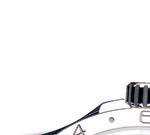
Do your research.





